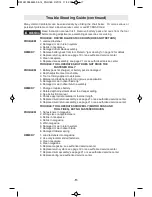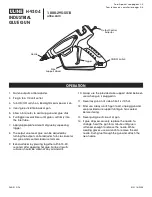
Do not disable or remove the work contact
element.
This tool is equipped with a safety
mechanism, the work contact element, to
reduce the risk of accidental firing. Disabling
this component can result in unintentional
firing.
Do not use the tool unless the work contact
element is working properly.
If the work
contacting element is not functioning correctly,
the tool can fire unexpectedly.
Always load nails into the tool's magazine
before the battery pack is connected.
Connecting the battery pack after loading nails
reduces the risk of unintentionally driving a nail
and injuring yourself or someone else.
When loading nails ensure that nails are
parallel with nose of tool.
If nails are not
parallel with nose the tool will misfire and nails
can be deflected, cause the tool to react in an
unexpected manner, and damage the tool.
When loading the tool's magazine, check
that the nail follower slides smoothly by
pulling with finger.
If not smooth, nails can be
driven at irregular angle.
Use only the nails meeting the criteria
listed in the “Specification” section of this
manual.
Nails not identified for use with this
tool can cause the tool to malfunction and
result in the risk of injury and/or tool damage.
Do not connect the battery pack when the
trigger or work contact element is
depressed.
Keep the tool pointed downward,
away from yourself and bystanders when
connecting the battery pack to reduce the risk
of accidental nail firing.
Keep hands and feet away from work
contact element of the tool during use.
Never place your hands or feet closer than 8
inches (200 mm) to the work contact element
of the tool. Nails can be deflected by the work
piece or driven away from the point of entry.
Use sufficient grip to maintain control of
the tool while allowing tool to recoil away
from work surface as nail is driven. Do
not attempt to prevent the recoil by
holding the tool with excessive force
against the work piece.
The tool will recoil
as the nail is driven. This is normal function
for the tool.
Never drive nails near flammable materials.
Some types of nails can spark out of the nose
during driving operation.
Know what is behind your work piece. Do
not fire nails into walls or floors without
assuring the area on the opposite side is
clear.
A nail could travel through the work
piece, striking someone.
Do not drive a nail on top of another nail.
This could cause the nail to be deflected or the
tool to react in an unexpected manner.
Do not attempt to drive nails at a steep
angle.
This could cause the nail to be
deflected or the tool to react in an unexpected
manner.
Use care when nailing thin material or
when working near the edges and corners
of the work piece.
Nails may drive through or
away from the work piece and injure yourself
or someone else. Be aware that the nail may
follow the grain of the wood causing it to
protrude unexpectedly from the side of the
work material. Drive the nails perpendicular to
the grain.
Do not drive nails into walls, floors or other
work areas without knowing what may be
damaged by the driven nails.
Nails driven
into live electrical wires, plumbing, gas piping,
or other types of obstructions can result in
electrocution, explosion, personal injury and/or
property damage.
Keep face and body parts away from back
of the tool when working in restricted
areas.
Sudden recoil can result in impact to
the body especially when nailing into hard or
dense material.
Always disconnect tool from battery pack
and remove nails from magazine before
leaving the area or passing tool to another
operator.
This avoids the risk of unintentional
operation.
Do not disconnect battery pack from the
tool with finger on trigger or the work
contact element depressed.
The tool can fire
when reconnected to the battery pack.
-4-
BM 2610034445 03-14_FNH180 3/27/14 11:52 AM Page 4




































